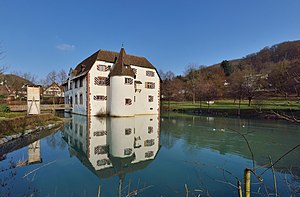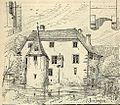Inzlinger moated castle
| Inzlinger moated castle | ||
|---|---|---|
|
Inzlinger moated castle with the surrounding park |
||
| Creation time : | circa 1400 | |
| Castle type : | Moated castle | |
| Conservation status: | Receive | |
| Standing position : | Enlisted knighthood | |
| Geographical location | 47 ° 35 '12 " N , 7 ° 41' 49" E | |
| Height: | 360 m above sea level NN | |
|
|
||
The Inzlinger moated castle , more rarely Reichenstein Castle , is located on the eastern edge of the municipality of Inzlingen in the Baden-Württemberg district of Lörrach . Almost half of the community is surrounded by the two rural communities of the canton of Basel-Stadt , Riehen and Bettingen, and the close proximity to Switzerland was also formative for the history of the moated castle. The moated castle is a landmark of the municipality and the district of Lörrach.
history
The moated castle was first mentioned in a document in 1511 as the property of Dr. med. Peter Wölfflin. Recently, the first mention has been dated to the year 1470, since a "castle or water house" is mentioned in a foundation of Heinrich Reich von Reichenstein . While a construction year around 1500 was previously assumed, a first construction is now assumed to be around 1400. In the early days only a solid angular house with associated farm buildings is assumed. The moat was probably only dug in the 16th century and probably never served military purposes as it offered no protection against the cannons that were already available at the time. It was probably a fad that was adopted from the Netherlands. In the Basel area, several such water towers visit: Schloss Bottmingen , Entenstein Castle , Castle Friedlingen (departed).
The oldest known illustration is a copper engraving published by Daniel Meisner in 1625. The copper engraving was probably made by Eberhard Kieser .
The castle was probably built in three phases, the first of which was probably from 1563 to 1566. It received its baroque appearance between 1674 and 1745, the baroque interior was probably done in the 18th century. Around 1750 there was a costly redesign with rococo stucco , Kniegetäfel, paneled doors, lintels , fireplace and inlaid floors that have survived to this day. In the knight's hall, in the corners of the stucco ceiling, there are images of the four castles of the Reichenstein Empire (Inzlingen, Reichenstein , Landskron , Brombach ). There is a statue of St. Nepomuk by Johann Ladner in 1731 in the park in front of the castle .
For centuries, the castle belonged to the Reich von Reichenstein family . The Basel mayor Heinrich Reich von Reichenstein († 1403) received high jurisdiction over Inzlingen in 1394 as a fiefdom from Margrave Rudolf III. transferred from Hachberg-Sausenberg .
In 1819/1820 the Reich von Reichenstein sold the castle for 19,000 guilders. It served first as a factory building ( silk ribbon weaving ) and then for about 100 years as an agricultural property owned by a family from the Schwarzbubenland in the canton of Solothurn .
In 1936 the baroque exterior painting was restored and in 1940/1941 the roof structure and the stucco ceilings. The municipality of Inzlingen acquired the castle in 1969 and had it rebuilt until 1978 so that it could serve as a town hall . There is also an upscale restaurant in the building that can be used for meetings, conferences and celebratory events.
location
The Inzlinger moated castle is located in the south-eastern settlement area of the municipality of Inzlingen at around 360 m above sea level. NN . The castle property is located south of the confluence area of the Riehenstrasse and the Schlossstrasse named after the property, both of which have the rank of district roads .
There is a parking lot to the west of the castle. The moat that completely surrounds the moated castle is fed by a small stream that flows into the moat in the southeastern part. A circular walking path leads completely around the facility. The path from the parking lot crosses the circular path to the west and leads over a wooden walkway to the entrance area of the castle in the inner courtyard. Another path (Lohweg) from the wooded slope of the Rührberg to the south leads over a gentle hill past a mini golf course down to the castle complex, which forks a few meters in front of it and joins the circular path at two points in the east. To the east of the castle is the sculpture "Tulip Bank at the Wasserschloss" by the artist Max Meinrad Geiger.
The castle and its surrounding park are particularly noticeable from the south-facing hillside towards the community and clearly stand out from the rest of the settlement area on the other side of the street.
reception
The moated castle was depicted on a 50-pfennig stamp of the definitive series of castles and palaces of the Deutsche Bundespost from 1980 ( Michel no. 1038) and in the same year also from the Deutsche Bundespost Berlin (Michel no. 615).
literature
- Hans Jakob Wörner , Judith Wörner: Wasserschloss Inzlingen . 2nd revised edition. Schnell und Steiner publishing house, Regensburg 1996, ISBN 3-7954-4025-4 . ( Little Art Guide 1139)
- Hans Jakob Wörner: The moated castle Inzlingen . In: Das Markgräflerland , Volume 2/1999, pp. 5-19. ( Digitized version of the Freiburg University Library )
- Judith Wörner, Hans Jakob Wörner: To the moated castle Inzlingen. In: Das Markgräflerland , volume 3/4 1975, pp. 271–277. ( Digitized version of the Freiburg University Library )
- Otto Deisler: The sovereignty of the village of Inzlingen. Shown from the files of the Generallandcsarchiv . In: Das Markgräflerland , issue 1/1958, pp. 1–28 digitized version of the Freiburg University Library
- Franz Xaver Kraus : The art monuments of the Grand Duchy of Baden . Tübingen / Leipzig 1901, Volume Five - District of Lörrach, pp. 16-19. ( ub.uni-heidelberg.de )
- Emil A. Erdin: The moated castle Inzlingen . In: News from the Swiss Castle Association , Volume 51, Issue 5, 1978. ( doi: 10.5169 / seals-162458 )
- Robert Feger: Castles and palaces in southern Baden. Weidlich Verlag, Würzburg 1984, ISBN 3-8035-1237-9 , pp. 125-133.
- Heiko Wagner: Theiss Castle Guide Upper Rhine. 66 castles from Basel to Karlsruhe . Konrad Theiss Verlag, Stuttgart 2003, ISBN 3-8062-1710-6 , pp. 72-73.
- Adolf Poinsignon : The pond castle Inzlingen near Loerrach . In: Schau-ins-Land , Volume 14, 1888, pp. 26–29. ( Digitized UB Freiburg )
Web links
- Entry on moated castle Inzlingen in the scientific database " EBIDAT " of the European Castle Institute
- Inzlinger Wasserschloss on the Baukunst in Baden website
- Illustration by Daniel Meisner from 1625: Intzlingen. Nothing is spun so small, it is compt to the sun ( digitized )
- Inzlinger moated castle on palaces and castles in Baden-Württemberg
Individual evidence
- ^ Wagner, p. 72
- ↑ s. Erdin p. 161; Erdin is wrong, however, when he names Wölfflin as rector of the University of Basel. In 1462 the rector was Werner Wölfflin
- ↑ s. Heiko Wagner in the entry in the castle database EBIDAT
- ↑ ss Wörner, Markgräflerland , p. 8
- ↑ s. Wörner, Markgräflerland , p. 9
- ↑ s. Daniel Meisner: Thesaurus Philo-Politicus or Political Treasure Chest [Volume 1, Book 1–8]; Intzlingen. Nothing is spun so small, it is compt to the sun ( digitized )
- ↑ Also in 1394, Margrave Rudolf was enfeoffed by the Bishop of Basel with the silver mines near Todtnau - a connection between the two processes has not been proven
- ↑ s. Erdin p. 163







